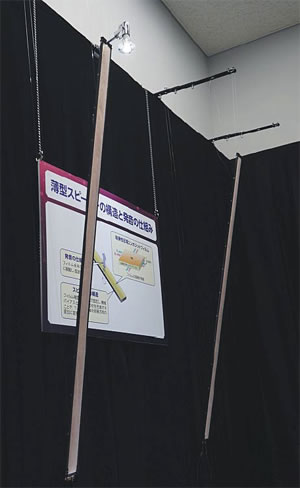Research Area
1.5 Sound systems providing a strong sense of presence
We are researching a 22.2 multichannel sound (22.2 ch sound) system for SHV and working on its standardization.
■SHV sound simultaneous production system
We are studying technologies to produce high-quality 22.2 ch sound efficiently and simultaneously while producing stereo and 5.1 ch sound.
In FY 2016, we studied an energy spectrum correction technique for downmixing sound which focuses on the coherence between 22.2 ch audio signals. In FY 2017, we improved its performance and conducted subjective evaluations with sound engineers engaged in program production(1). As Table 1-1 shows, the sound obtained with the maximum amount of correction, both in the suppression process and the amplifying process, was rated as the most appropriate downmixed sound. This demonstrated the sound quality improvement effect of the proposed technique.
We are also studying an upmixing technology for using sound materials recorded in stereo for 22.2 ch sound production. We developed a technique for separating components according to the mutual correlation of stereo signals by using an adaptive filter to generate 22.2 ch sound materials(2).
Table 1-1. Evaluation result of correction amount in suppression and amplification processes

■Reproduction of converted SHV sound
We are researching technologies for the easy reproduction of 22.2 ch sound at home. We continued with our research on binaural reproduction using line array loudspeakers. In FY 2017, we devised a design method for a reproduction controller that increases the robustness against system perturbations and external disturbances(3) and implemented it into the signal processor that we are developing in cooperation with Sharp Corporation.
We also proposed a method for the low-order and high-accuracy modeling of head-related transfer functions including the characteristics of an expected reproduction environment and developed a signal processor for reproducing 22.2 ch sound with headphones using this method.
■Standard test materials for 3D multichannel stereophonic sound systems
In FY 2017, the Institute of Image Information and Television Engineers published Series A of standard test materials for 3D multichannel stereophonic sound systems. Toward this achievement, we contributed to the sound source production conducted by ARIB and prepared an explanatory document describing evaluation items and recording conditions.
■Acoustic devices
We exhibited the 22.2 ch sound single-unit microphone that we developed in FY 2016 at the NHK STRL Open House 2017. We also contributed to the production of standard test materials for 3D multichannel stereophonic sound system. Using our microphone, we recorded various sounds such as the performance of octets by wind and string instruments and ambient sound at an amusement park. In addition, we studied beam forming method in order to improve the performance of separation between channels.
We developed a thin loudspeaker using a piezoelectric electroacoustic transduction film that could be applied to loudspeakers for flat-panel TV and 22.2 ch sound loudspeakers for home use and exhibited it at the NHK STRL Open House 2017. This research was conducted in cooperation with Fujifilm Corporation.

Figure 1-7. Appearance of thin loudspeakers
■Audio services for next-generation terrestrial broadcasting
We developed a real-time encoder/decoder for 22.2 ch sound using the MPEG-H 3D Audio LC profile(4) to study an audio coding scheme for next-generation terrestrial broadcasting. This research was conducted in cooperation with the Fraunhofer Institute for Integrated Circuits.
We devised a serial form of audio definition model (ADM), which is metadata used for object-based audio, and a method to convey serial ADM. We also prototyped both transmitter and receiver of serial ADMs using a digital audio signal interface.
■Standardization
At ITU-R, we prepared a Preliminary Draft New Recommendation on serial ADMs on the basis of a joint proposal by Japan, the US and the UK. At the Society of Motion Picture and Television Engineers (SMPTE), we proposed a draft of the standard for conveying serial ADMs using AES3 digital audio signal interface. At ARIB, we set up a group to study the requirements for next-generation audio services and began activities.
At the Japan Electronics and Information Technology Association (JEITA) and the International Electrotechnical Commission (IEC), we produced a committee draft for a vote on a standard for transmitting a 22.2 ch sound signal stream encoded by MPEG-4 AAC using an optical interface to reproduce 22.2 ch sound at home. Additionally, we contributed to the revision of a standard for transmitting 22.2 ch sound signal stream encoded by MPEG-4 AAC using an HDMI specified by the Consumer Technology Association (CTA).
At JEITA and IEC, we continued with our works to revise a standard for the general channel allocation including 22.2 ch sound system to add channel labels for various multichannel sound systems.
At AES, we contributed to the publication of technical guidelines which prescribe that each country’s broadcasting rules (i.e., -24LKFS for Japan) should be followed in principle for the target loudness of over-the-top television programs(5).
| [References] | |
| (1) | T. Sugimoto and T. Komori: “Tone compensation method for downmixing of 22.2 ch sound,” ITE Winter Annual Convention 2017, 12C-5 (2017) (in Japanese) |
| (2) | Y. Sasaki, T. Komori and T. Nishiguchi: “A study of upmix algorithm from stereo to 22.2ch audio,” ITE Winter Annual Convention 2017, 31B-3 (2017) (in Japanese) |
| (3) | K. Matsui, A. Ito, S. Mori, M. Inoue and S. Adachi: “A method to relieve the binaural reproduction controller applying output tracking control,” Autumn meeting of the Acoustical Society of Japan, 1-P-31 (2017)(in Japanese) |
| (4) | ISO/IEC 23008-3:2015/AMD3:2017 (2017) |
| (5) | “Loudness Guidelines for OTT and OVD Content,” Technical Document AESTE1006.1.17-10 (2017) |